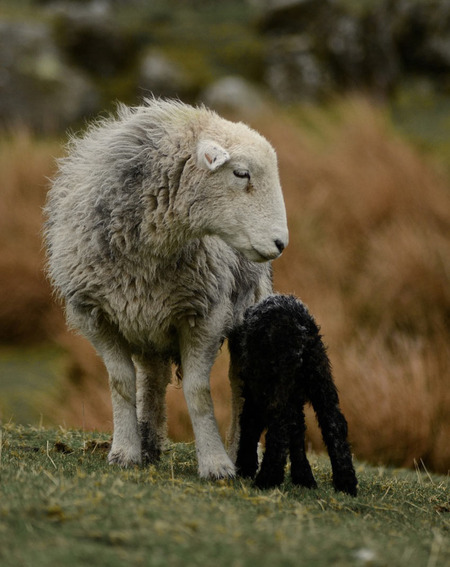Pure Herdwick Tweed bags, accessories, cushions & caps made with wool from the English Lake District.
The History of Herdwick
Herdwick sheep are born completely black but slowly their fleeces turn so by the time of their first shearing their fleeces are chocolaty brown and their faces and legs a snowy shade of white. By the second shearing their fleece is grey, and as they age it becomes a rich creamy white colour. This diversity of colour is a real asset when crafting beautiful designs and utilising the natural shades of the wool. These beautiful natural tones echo the bleak beauty of the landscape of The Lake District.

The name Herdwick comes from the Old Norse herdvyck which literally means sheep pasture. The quality of the wool produced by Herdwick sheep is unique in its durability. It has protective properties, making it a very robust and hardy fabric for practical use. Herdwick sheep have been known to survive under blankets of snow for three days using only their thick coats as warmth and sustenance.
There are much fewer animals in the Herdwick breed than most other commercial breeds of livestock, though more efforts are being made to preserve the breed lately. Especially as they are such an important part of Lakeland heritage.
Although the exact story of how the Herdwick breed came to Britain is unknown, there are several suggestions. Some believe that the ancestors of the Herdwick breed were brought to Britain with the Nordic settlers during the Viking invasions. Others believe that they arrived in a Spanish Armada ship. Whatever the truth behind the mystery, by the end of the 12th century they were firmly established in the Lake District.
Herdwick sheep live all year on England's highest and roughest terrain which also has the country's highest rainfall. The heart of Herdwick country is the western and central parts of the Lake District National Park.
Much of the farmland is unfenced fell grazing and includes large areas of common land. The Lakeland Herdwick sheep learn through shepherding and grazing with their mothers where on the open fell their farm's grazing area is. This is known locally as the "heaf". This is a complex system dependant on succeeding generations of female sheep being taught where they live. As the sheep feed on the herbage of the fells; grasses, heather and plants such as bilberry, they maintain the unique landscape.
Today around 50,000 Lakeland Herdwick sheep are kept on 120 farms in the Lake District some owned by the National Trust, which were left to them by Beatrix Potter (Mrs Heelis). 95% of Herdwicks live within 14 miles of Coniston.
In the late 20th century wool prices dropped so low that farmers would burn Herdwick fleeces as waste. The cost of shearing the sheep being more than the money they could sell the fleece for. The National Trust has now protected this and act as a wool merchant to ensure the fair trade of all wool.
Part of preserving this fascinating breed is by utilising the wool to the best advantages. The Herdwick bags are crafted exclusively from Herdwick tweed. The fleece is sheared in Cumbria, before being cleaned, spun and woven and then manufactured into the stunning range of bags.
Shearing typically occurs once a year, during the summer months. As the sun comes the removal of their heavy coats is very welcome to the sheep. The removal of the fleece also helps with the welfare of the sheep. In the summer months various flies get attracted to the sheep and can lay their eggs in the wool, if maggots hatch onto the skin of the sheep the effects can be highly detrimental. By removing the fleece we are eliminating the chances of this happening. Even with the electric clippers that are used today it is still a very physical and skilled job.
Once the fleeces have been sheared off in one piece they are carefully rolled and placed into large wool sacks in preparation for collection. The cleaning and spinning process takes place at the mill. First the fleeces are sorted to ensure quality then they are thoroughly scoured to ensure that they are clean, next they are spun into yarn. It’s a very involved process, and all this before the weaving even takes place. Traditionally, a spinning wheel would have been used to handspin the wool before handweaving it into cloth. Nowadays we use machinery to speed up the process, but there is still meticulous attention to detail and the speedier results mean a fairer wage and a faster turnover which really helps with the conservation of the Herdwick breed. Once the fabric has been diligently woven, then the bags are lovingly assembled. In keeping with the traditional roots of the Herdwick project this also happens in Cumbria. Making the Herdwick bags Cumbrian from conception to birth.

